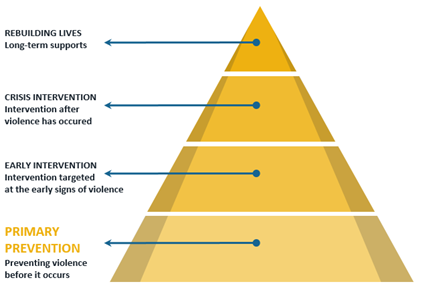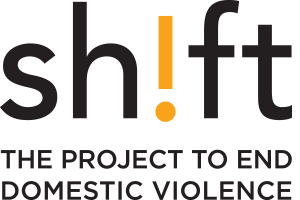Understanding Primary Prevention
We’re tackling root causes to stop violence before it starts
What is Primary Prevention?
Primary prevention means changing the cultural and structural conditions that fuel harm, reducing risk factors, and strengthening what keeps people and communities safe. 1
By moving upstream, we can stop perpetration before it happens — and that’s key to ending gender-based violence for good.
At Shift, we believe that “perpetrators are made, not born.”1. And if we want to stop producing perpetrators, we must transform the environments – our homes, schools, workplaces, institutions — that create or enable them.2
Why Primary Prevention?
Primary prevention is about creating the conditions for safety, equity, and peace— and where violence has no place to take hold.
Rather than waiting to respond to harm, we focus on building strong, connected systems and communities that support well-being for everyone. This is long-term, transformative work that calls on all of us to be part of the solution. 3
Primary prevention is hope in action — changing conditions today to create safety for tomorrow.

Suggested citation: Wells, L. (2022). Understanding primary prevention. University of Calgary, Shift: The Project to End Domestic Violence.
What Does Primary Prevention Look Like?
Effective primary prevention approaches must be grounded in a human rights and ecological approach – one that works to transform oppressive systems and structures, strengthen pro-social supports for individuals and families, and shift the social conditions that harm communities.
At Shift, we advance primary prevention by:
- Conducting and sharing research to support informed, prevention-focused decision-making
- Co-creating prevention programs, policies, and legislation with diverse partners
- Supporting discourse change at local, regional, national, and international levels
- Championing evidence-based models that can be embedded in strategies, programs, practices, policies, and initiativesProviding leadership and support to communities, organizations, and governments to apply primary prevention research in real-world settings
References
1 Flood, M., & Dembele, L. (2021). Putting perpetrators in the picture. Centre for Justice, (13). https://research.qut.edu.au/centre-for-justice/wp-content/uploads/sites/304/2021/06/Michael-Flood-briefing-paper-issue-13.pdf
2 The Missouri Coalition Against Domestic and Sexual Violence (2012). Embracing prevention as social change. http://www.calcasa.org/wp-content/uploads/2012/04/Embracing-Prevention-as-Social-Change-How-to-Build-Organizational-Capacity-for-Prevention.pdf; Flood, M., & Dembele, L. (2020). Putting perpetrators in the picture: Mapping the extent and character of violence perpetration in Australia. Paper presented at the STOP Domestic Violence, Gold Coast, Australia; Prevention Institute. (2017). A health equity and multisector approach to preventing domestic violence. Author.
3 The Missouri Coalition Against Domestic and Sexual Violence (2012). Embracing prevention as social change. http://www.calcasa.org/wp-content/uploads/2012/04/Embracing-Prevention-as-Social-Change-How-to-Build-Organizational-Capacity-for-Prevention.pdf


